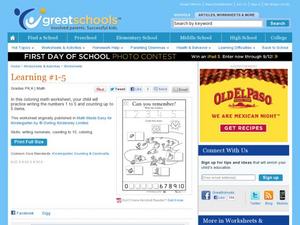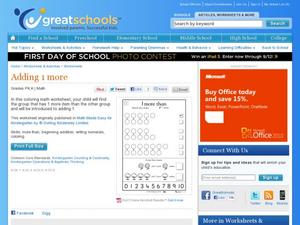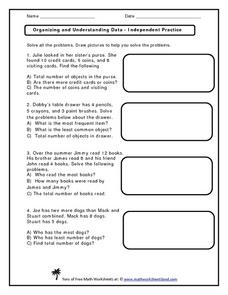Curated OER
Addition Exercises
For this problem solving worksheet, students count how many different objects are on 10 lines. Students place their answers at the end of each line. Students then add all 10 lines up together for 1 grand total.
DK Publishing
Learning 1 - Write the Number
Begin your study of single-digit numbers with this activity on the number one. Young counters first trace and write the digit several times. Next, they practice counting by recording how many objects are in each image (always one)....
Curated OER
See, Say, Write, and Count! Worksheet
In this number recognition worksheet, students say the numbers, trace the number word, and then write the number word on the lines for numbers 1-10.
Curated OER
Represent Numbers to 10
In this counting learning exercise, students determine which sets of pictures shown given numbers of objects, numbers 1-10 only. Students circle the correct number in each set.
Curated OER
Finding 10s
For beginners to addition, sets of objects are the ideal way to make this concept understandable. For each of these sets they ring 10 and count the remaining. Then, scholars fill in the addends as 10 and the remaining number. The sums...
Curated OER
More Than or Less Than?
How many apples is less than five? Each of these problems has two images, one with quantifiable details and one without (i.e. a tree with apples and an empty tree). Answers will vary as young counters draw objects onto the second image...
Curated OER
Subtracting
Help kids visualize subtraction by assigning these sets of objects for them to subtract. They examine an example before completing the seven equations on their own. For each, learners cross out the subtrahend value and count the...
Curated OER
Sets Of
Represent multiplication as sets of items for beginners to this concept. They look at six familiar object sets and determine the total number of legs by counting the sets. There is some scaffolding here, as the first is done for them and...
Curated OER
Reading Numbers
Teach number value to 20 through sets of objects. Young pupils use the number given for each of the four sets to determine how many should be colored in. How many are left? There is an addition box that has been left blank so scholars...
Curated OER
Count the Feet
In this count the feet activity, students count the number of objects' feet and check. In this fill in the blank activity, students write four answers.
Curated OER
My Book of Numbers that Make the Number 10
This wonderful packets allows learners to practice number bonds for ten. There are a total of 6 pages where students will complete various addition problems. Some activities suggests using stickers, however, drawing symbols is a perfect...
Curated OER
Counting More and Counting Less
In this counting worksheet, students will count the items in each group and write the numbers on the lines. For the first 6 problems, students will circle the group that has more items. In the last 6, students will circle the group that...
Curated OER
How Many Do You See?
In this math worksheet, students examine 5 sets of pictures of machines and robots. Students count the objects in each set and write the number in the blank.
Curated OER
What is One Less?
In this counting worksheet, students count each group of objects and then count back one to find the new total. Students write number sentences and totals for nine problems.
DK Publishing
Can You Remember? Learning #1-5
Start from the beginning with new counters! They practice number concepts, tracing five digits: 1, 2, 3, 4, and 5. Next, scholars count the number of each object in an illustrated pond scene. How many suns? How many ducks? There are five...
DK Publishing
Adding One More, 1 More Than
Gain familiarity with numbers 0-10 with a counting and addition worksheet for beginners. Scholars examine three pairs of circles, checking off the one representing one more than the other. Then, they read illustrated number sentences and...
DK Publishing
Addition: Count and Color, part 2
Introduce young counters to addition through coloring as they examine number sentences represented by sets of objects. Learners count the two addends and color in the sum by counting out the total in a final set. There is an example, and...
DK Publishing
Addition: Count and Color, part 3
Approach addition with sets of objects to show scholars the operation visually. There are four sets of images here arranged as addends in an addition number sentence. Learners count them and color in the total in a final set. All answers...
Curated OER
Organizing and Understanding Data - Independent Practice
Provide your first graders with an opportunity for independent practice organizing and understanding data. The ten story prompts on this three-page worksheet asks learners to solve problems involving concepts of the total number of...
Curated OER
Use Estimation to Compare Numbers
"Take a walk" with this instructional activity and estimate how many birds, ants, turtles, flowers and children getting on a bus that you see. Based on the size of a single set of 10 objects, learners estimate how many are in the whole...
Math Worksheets Land
Compare Two-Digit Numbers - Guided Lesson
Practice comparing number values in a variety of activities on this learning exercise. Youngsters complete a statement comparing 20 to 20, choosing from three options: is greater than, is less than, and is equal to. Then, they put four...
Curated OER
Counting to 10 (1)
In this early childhood counting to 10 worksheet, students practice their counting skills as they examine 9 boxes of objects. The number of objects in each box is matched to the appropriate number on the number line.
Curated OER
My Test Book: Counting Practice
In this math skills worksheet, students solve 10 multiple choice math problems that require them to count the picture objects. Students may view the correct answers.
Curated OER
Matching Sets of Objects: Birds and Worms
In this matching sets worksheet, students count the animals in each of 3 sets on one side of the page. Students draw lines to match them with sets on the opposite side that have the same number of animals in them.























